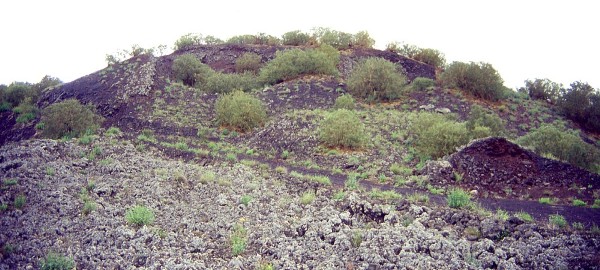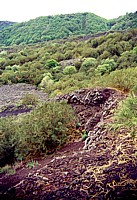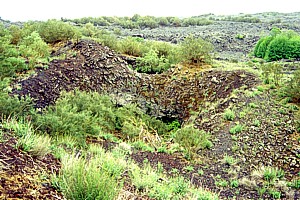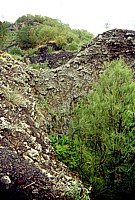| Etna
index |
||
| Geology | Geological history | Cones and craters |
| Eruptive characteristics | Eruptions before 1971 | Eruptions since 1971 |
| Etna and Man | References | Web sites |
| Weather forecasts | FAQ | Latest news |
Mamma
Etna's countless children
Monte Leone (1883 eruption)
S flank, 14.999736° E, 37.657096° N
Summit elevation: 1099 m
![]()
During
the second half of March 1883, an impressive seismic crisis affected the
eastern, southern and southwestern flanks of Mount Etna. Two days after
the onset of the crisis, on 22 March 1883, an enormous but non-eruptive
fracture system started to open at the summit and rapidly propagated down
the south flank to an elevation of about 1000-1100 m, where a short eruptive
fissure became active. This dramatic succession of events aroused fears
in the population of Nicolosi, located about 5 km further downslope to
the southeast, because the devastating 1669 eruption
had begun in a similar (though much more violent) manner. In 1883, however,
things took a very different course. In contrast to the 1669 eruption,
which was the second largest historical flank eruption of Etna, the 1883
eruption was to become the smallest historical flank eruption of the volcano.
Eruptive activity continued for only two days and produced a small lava
flow about 250 m long and a series of small cones, the largest of which
was given an impressive name: Monte Leone, mountain of the lion. Three
years later, another eruption occurred higher upslope (at Monte
Gemmellaro) and this time Nicolosi was seriously threatened by a lava
flow.
The site of the 1883 eruption lies in a somewhat deserted area, in an
"island" (kipuka) surrounded by lavas of the 1892 eruption of
the Monti Silvestri, and once more invaded by a lava flow during the 2001
eruption. Already before that latest eruption, the small pyroclastic cones
of Monte Leone were so unconspicuous that it was not all that easy to
find them; the 2001 lava flow buried much of the access paths and thus
Monte Leone is now more isolated than before. The main cone of the cluster
rises barely 15 m above its base, and a still smaller cone lies at its
southern base. Bushes and small trees grow on the cones and within their
small craters. The 2001 lava flow passed only about 50 m to the west of
these cones and for several days threatened to bury them.
I visited and climbed Monte S. Leo on 22 April 2000, when most of these
photographs were taken.
Copyright © Boris Behncke, "Italy's Volcanoes: The Cradle of Volcanology"
Page set up on 15 March 2004




